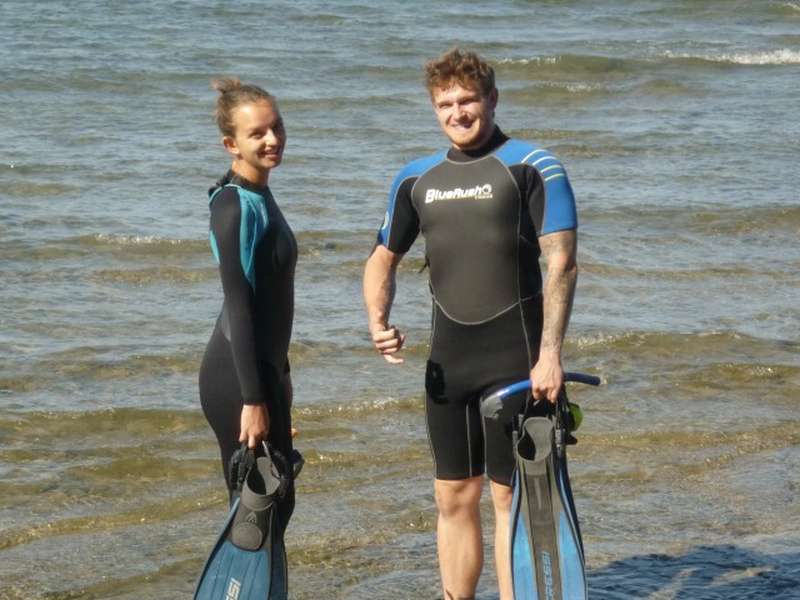The Fiji Islands are often referred to as ‘The Paradise Islands’. The friendliness of the people, the sun, the stunning nature. It’s simply what your dream holiday is made off. The country is not only offering relaxation, but also adventurous activities, especially involving the warm waters of the South Pacific.
You can spend your dollars on scuba diving, stand-up paddling, surfing, flyboarding, game fishing, jet skiing, and para-sailing. These activities are not only costly but you also need to be physically in very good shape, so those won’t be for everyone.
Snorkeling in Fiji
However, there is one activity, which is – as long as you know how to swim – very affordable and great fun: I am talking about snorkeling in Fiji. With a basic outfit, a mask, snorkel, and fins (and maybe a wetsuit in winter) you can already start enjoying Fiji’s underwater beauty. Even in shallow water close to the shore, you will encounter fish swimming along with stunning coral while you are carried through the buoyancy of the saltwater and enjoy some of the best snorkeling in the world.
Nevertheless, the ocean is an environment you have to adapt to. To stay safe when snorkeling, use common sense and obey some safety rules. I put together 10 basic rules for safe snorkeling:
1. Keep to a buddy system
Never go out alone! Find a snorkel buddy who is accompanying you on your snorkeling trip and who stays nearby at all times. In the unlikely event, you should need help, your buddy can assist you and you will both benefit in terms of convenience, safety, and fun. If no-one wants to share your snorkeling adventure, make sure you tell someone on shore where you want to snorkel (be sure you know your physical limits) and set a time when you will be back …and do report back.
2. Sun protection
The sun is strong in Fiji. Even on a cloudy day, you are likely to catch a sunburn if you go snorkeling without any sun protection. A long-sleeved shirt and Lycra pants will do the job protecting your body. Use a baseball or swim cap for your head. Careful with sun lotion, if put on your face it might interfere with the sealing of the mask, therefore the mask might be leaking and the sun lotion might sting in your eyes if it mixes with saltwater. Choose environmental and coral friendly sun lotion when snorkeling in the tropics as regular sun lotion does damage the fragile marine ecosystem.
3. Check equipment
Mask
Before you go in the sea, check that your mask is not leaking and that straps are not brittle. To test your mask, place it against your face without the strap and inhale through your nose. A properly fitting and not leaking mask will seal and stay on your face after inhaling through your nose. Next, clean your mask by spitting saliva on the glass, wipe it and wash it out with saltwater. You do this to prevent your mask from fogging up. Place now the strap over your head and adjust. The strap should only be supporting and not pulled tight.
Snorkel
A snorkel allows you to keep breathing while your head is submerged, you generally wear it on the right side of your head and fix it with a snorkel holder at the mask strap.
When looking for a snorkel, I would recommend asking for what is called a “purge” snorkel. If water enters your snorkel and your mouth exhale forcefully, the water will be drained out of the tube and the purge valve. Keep the tip of your tongue against the roof of your mouth creating a splash guard and inhale then carefully to avoid remaining water entering your throat.
Fins
Fins allow you to swim like a fish. There are 2 kinds of fins. For the warm waters of Fiji, the close heel kind are just fine. The open heel fin is more for scuba diving and most require neoprene boots. Important is, that fins fit comfortably otherwise you might encounter cramps.
4. Watch your surrounding
Before you go for a snorkel, watch the boat traffic and stay far away from the direction the boats are generally heading. Due to the sunlight, it might be very difficult for a boat driver to see a snorkeler until the boat is close, even if the engine is cut then the drag might push the boat into you and hurt you.
5. Entering water from shore
You might have to walk out over a rocky shoreline to have water deep enough to submerge yourself in the water. Even in sandy lagoons creatures like baby stingrays might be buried in the sand and although being a baby, the sting of its tail is effective and hurts for quite a while ( have experienced this myself). If you decided on full foot fins instead of neoprene shoes and strap fins then make sure to don those early and always walk backward when wearing fins until water is deep enough to swim.
6. Check tides and currents
If a current is present start snorkeling first swimming against the current and return with the current. Avoid rip currents, they occur mostly in passages and can carry you easily out into deep water. The same can happen if you snorkel at the tidal change from high tide towards low tide. The outgoing tide might pull you towards deep water.
Tide table for Fiji
7. Know the signs for ‘I am okay’ and ‘I need help’:
For ‘Okay’ you form a big ‘O’ with both your arms over your head.
For ‘Help’ you wave a stretched arm from the surface to straight over your head and back. Repeat that.
8. Stay calm:
If a problem occurs to get on your back and inhale deeply. The buoyancy of the saltwater will carry you and you can relax until you feel fit enough to continue. Ask your buddy to assist you.
9. Practice proper snorkeling techniques:
Snorkel breathing:
Put your snorkel in your mouth and let your lips seal around it, bite gently on the nipples of the mouthpiece. Now breathe slowly and deeply. If your snorkel was submerged there is no need to take it out of your mouth to clear it from water, just exhale forcefully in your snorkel when back on the surface while tilting your head slightly backward. To avoid breathing in remaining splash water, use your tongue as a splash-guard, by placing the tip of your tongue on the roof of your mouth. Now breathe carefully past water which is remaining in your snorkel.
Swimming:
Keep your body streamlined, arms on your side, snorkel top out of the water and fins below the surface. Swim slowly and relaxed.
10. Marine life:
Although most marine life is harmless, some have defensive mechanisms that can injure you. So do not stand on coral and do not touch marine life, nor take out any shells. After all, when snorkeling you are entering their habitat, so please treat it with respect.



